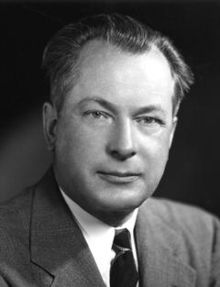Samuel King Allison
| Samuel King Allison | |
|---|---|
 |
|
| Born |
November 13, 1900 Chicago |
| Died | September 15, 1965 (aged 64) Chicago |
| Citizenship | American |
| Fields | Physics |
| Institutions |
University of California, Berkeley University of Chicago Los Alamos National Laboratory |
| Alma mater | University of Chicago (B.S. 1921, Ph.D. 1923) |
| Thesis | Atomic Stability III, the Effects of Electrical Discharge and High Temperature (1923) |
| Doctoral advisor | William Draper Harkins |
| Doctoral students |
James Cronin Nicholas M. Smith |
| Known for | Manhattan Project |
| Notable awards | Medal for Merit (1946) |
Samuel King Allison (November 13, 1900 – September 15, 1965) was an American physicist, most notable for his role in the Manhattan Project, for which he was awarded the Medal for Merit. He was director of the Metallurgical Laboratory from 1943 until 1944, and later worked at the Los Alamos Laboratory — where he "rode herd" on the final stages of the project as part of the "Cowpuncher Committee", and read the countdown for the detonation of the Trinity nuclear test. After the war he was involved in the "scientists' movement", lobbying for civilian control of nuclear weapons.
Samuel King Allison was born in Chicago, Illinois, on November 13, 1900, the son of Samuel Buell Allison, an elementary school principal. He was educated at John Fiske Grammar School and Hyde Park High School. He entered the University of Chicago in 1917, and participated in varsity swimming and water basketball, while majoring in mathematics and chemistry. He graduated in 1921, and then embarked on his PhD in chemistry under the supervision of William Draper Harkins, writing his thesis on "Atomic Stability III, the Effects of Electrical Discharge and High Temperatures", a topic closely related to experimental physics.
Allison was a research fellow at Harvard University from 1923 until 1925 and then at the Carnegie Institution from 1925 until 1926. From 1926 until 1930 he taught physics at University of California, Berkeley as an instructor, and then as an associate professor. While there he met and married Helen Campbell. They had two children, a son, Samuel, and a daughter, Catherine.
...
Wikipedia
